 Website:
Thermal Detection
Website:
Thermal Detection
Catalog excerpts

ABSTRACT Thermal Detection has over 30 years experience manufacturing PT100 temperature probes. The following paper outlines the key design considerations for successful temperature measurement. DESIGN CONSIDERATIONS FOR ACCURATE TEMPERATURE MEASUREMENT USING PT100 DETECTORS Thermal Detection Limited Unit 6, Primrose Hill Industrial Estate Orde Wingate Way Stockton-on-Tees, England, TS190GA Email: sales@thermal-detection.com Web: www.thermal-detection.com
Open the catalog to page 1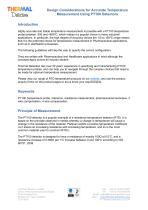
Design Considerations for Accurate Temperature Measurement Using PT100 Detectors Introduction Highly accurate and stable temperature measurement is possible with a PT100 temperature probe between -200 and +850°C, which makes it a popular choice in many industrial applications. In particular, the high degree of accuracy across the -50 to 150ºC range means that it is the preferred choice for temperature measurement in Pharmaceutical applications, such as in sterilisation processes. The following guidelines will help the user to specify the correct configuration. They are written with...
Open the catalog to page 2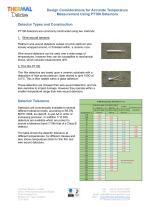
Design Considerations for Accurate Temperature Measurement Using PT100 DetectorsDetector Types and Construction PT100 detectors are commonly constructed using two methods: 1. Wire wound sensors. Platinum wire wound detectors consist of a thin platinum wire loosely wrapped around, or threaded within, a ceramic core. Wire wound detectors can be used over a wide range of temperatures, however they can be susceptible to mechanical shock, which induces measurement drift. Thin film detectors are based upon a ceramic substrate with a deposition of high purity platinum, laser etched to give 100Q...
Open the catalog to page 3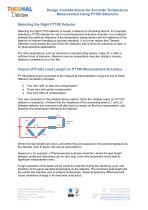
Design Considerations for Accurate Temperature Measurement Using PT100 Detectors Selecting the Right PT100 Detector Selecting the right PT100 detector is usually a balance of competing factors. For example, selecting a PT100 detector for use in a pharmaceutical autoclave chamber, it is a balance between the optimum tolerance of the temperature measurement and the resilience of the detector to frequent handling by process operators. It is for that reason that Thermal Detection recommends the use of thin film detectors with a minimum tolerance of class ‘A‘ for pharmaceutical applications. For...
Open the catalog to page 4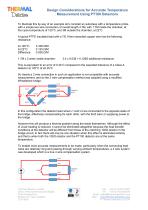
Design Considerations for Accurate Temperature Measurement Using PT100 Detectors To illustrate this by way of an example let’s consider an autoclave with a temperature probe with a simple two wire connection of overall length 4.7M, with 1.7M inside the chamber, at the cycle temperature of 120°C, and 3M outside the chamber, at 22°C. A typical PTFE insulated lead with a 7/0.16mm stranded copper wire has the following resistance: At 120°C: At 22°C: Difference: 1.7M x 2 wires inside chamber: This is equivalent to an error of 0.34°C compared to the expected tolerance of a Class A detector at...
Open the catalog to page 5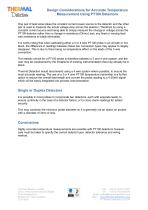
Design Considerations for Accurate Temperature Measurement Using PT100 Detectors One pair of lead wires takes the constant current power source to the detector and the other pair is used to measure the actual voltage drop across the detector. Therefore by using a constant current source and being able to simply measure the change in voltage across the PT100 detector rather than a change in resistance (Ohms Law), any fixed or varying lead wire resistance is totally eliminated. It is worth noting that when calibrating either a 3 or 4 wire PT100 probe in an oil bath or hot block, the...
Open the catalog to page 6All Thermal Detection catalogs and technical brochures
-
Conax EG Electrode Gland
4 Pages
-
Conax TG Multi Wire Gland
4 Pages
-
PT100
2 Pages
-
PSTC Plain Stem Thermocouple
2 Pages
-
MD series
3 Pages
-
LD Series
3 Pages
-
Solid Drilled Thermowells
2 Pages
-
Fabricated Thermowells
2 Pages
-
Steam Quality Test Kits
13 Pages
-
Compression Fittings
9 Pages
-
Hygenic Surface Probe HSP
1 Pages
-
FD100 Freeze dryer probe
1 Pages
-
Validation Clamp VC
2 Pages
-
Standard Steam Test Pack
2 Pages



























































